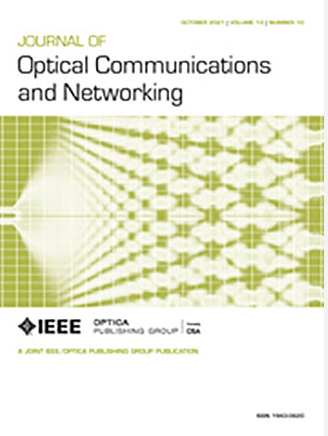DiReNet: a distributed topology and routing joint optimization architecture for optical circuit switching networks
IF 4.3
2区 计算机科学
Q1 COMPUTER SCIENCE, HARDWARE & ARCHITECTURE
引用次数: 0
Abstract
Optical circuit switching networks dynamically adjust their topologies to meet varying communication patterns. Conventional methods rely heavily on comprehensive traffic data collection, centralized processing, and complex resource allocation strategies. However, as networks scale to hundreds of thousands of nodes, these centralized solutions become impractical, imposing overwhelming demands on the computational and storage capacities of controllers. This results in a significant degradation of network reconfiguration efficiency and responsiveness. To address these challenges, we propose DiReNet, a distributed architecture for joint topology and routing optimization in optical circuit switching networks. Unlike traditional traffic matrix-based centralized approaches, DiReNet leverages link modification requests as a more effective reconfiguration metric for large-scale networks. Each node independently monitors link utilization and triggers localized reconfiguration, using in-band control and paired transmission to reduce control overhead. DiReNet also features a flooding-negotiation routing mechanism with one-hop relay limits, coordinating traffic draining, flooding, and feedback to ensure efficient resource utilization and seamless operation during reconfiguration. Simulations show that DiReNet’s reconfiguration delay is nearly unaffected by network scale, remaining only 24.8 µs even with 70,000 servers. Under real-world workloads from Google data centers, Meta’s Hadoop clusters, and web search traffic, DiReNet outperforms the classical distributed scheme RotorNet with higher throughput and lower latency while reducing queue length requirements byDiReNet:用于光电路交换网络的分布式拓扑和路由联合优化架构
光电路交换网络动态调整拓扑结构以适应不同的通信模式。传统的方法严重依赖于全面的交通数据收集、集中处理和复杂的资源分配策略。然而,当网络扩展到数十万个节点时,这些集中式解决方案变得不切实际,对控制器的计算和存储能力提出了巨大的要求。这将导致网络重构效率和响应性的显著降低。为了解决这些挑战,我们提出了DiReNet,一种用于光电路交换网络中联合拓扑和路由优化的分布式架构。与传统的基于流量矩阵的集中式方法不同,DiReNet利用链路修改请求作为大规模网络的更有效的重新配置度量。每个节点独立监控链路利用率并触发局部重新配置,使用带内控制和配对传输来减少控制开销。DiReNet还具有泛洪协商路由机制,具有一跳中继限制,协调流量排水、泛洪和反馈,以确保在重新配置过程中有效利用资源和无缝运行。仿真结果表明,DiReNet的重构延迟几乎不受网络规模的影响,即使在7万台服务器上,其重构延迟也仅为24.8µs。在谷歌数据中心、Meta的Hadoop集群和web搜索流量的实际工作负载下,DiReNet以更高的吞吐量和更低的延迟优于经典的分布式方案RotorNet,同时将队列长度要求降低了${3.4}\times$,重构速度要求降低了${100}\times$。与传统的集中式方案(如KM、iSLIP和Solstice)相比,DiReNet实现了高达100倍的延迟和队列长度降低,并将流完成时间缩短了21.49%-73.7%。
本文章由计算机程序翻译,如有差异,请以英文原文为准。
求助全文
约1分钟内获得全文
求助全文
来源期刊
CiteScore
9.40
自引率
16.00%
发文量
104
审稿时长
4 months
期刊介绍:
The scope of the Journal includes advances in the state-of-the-art of optical networking science, technology, and engineering. Both theoretical contributions (including new techniques, concepts, analyses, and economic studies) and practical contributions (including optical networking experiments, prototypes, and new applications) are encouraged. Subareas of interest include the architecture and design of optical networks, optical network survivability and security, software-defined optical networking, elastic optical networks, data and control plane advances, network management related innovation, and optical access networks. Enabling technologies and their applications are suitable topics only if the results are shown to directly impact optical networking beyond simple point-to-point networks.

 求助内容:
求助内容: 应助结果提醒方式:
应助结果提醒方式:


